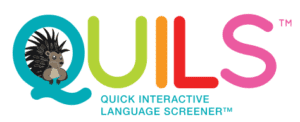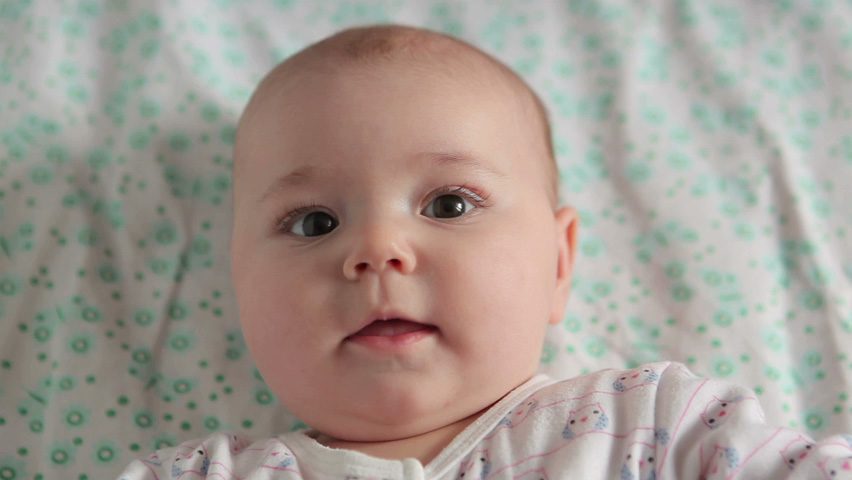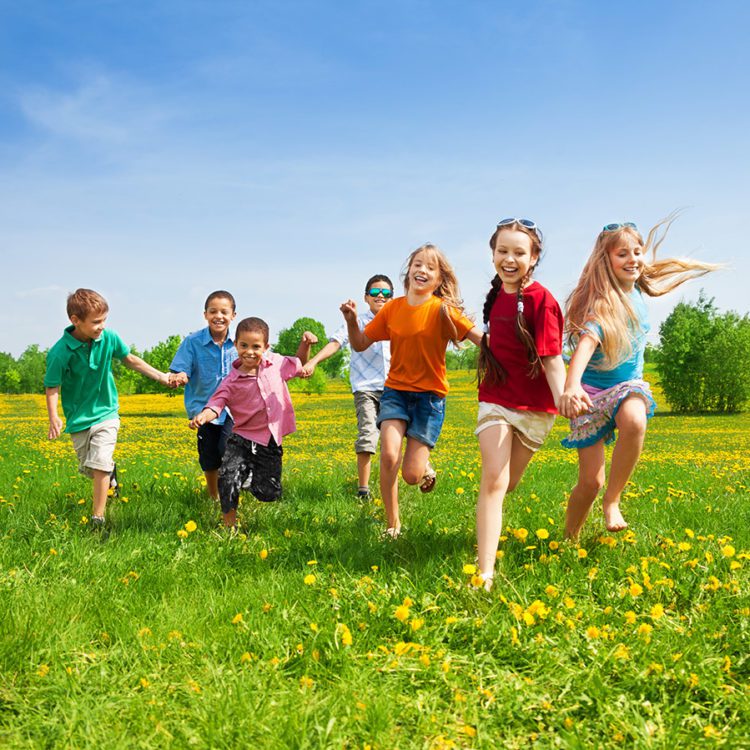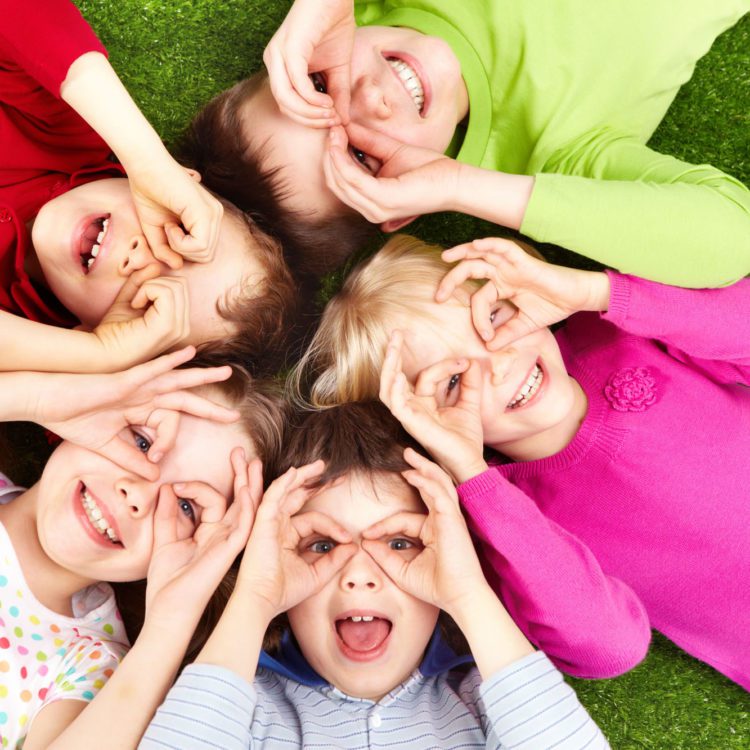OVERVIEW
 Language is the single best predictor of later language, reading, math and even social skills. Our laboratory studies how infants begin the journey of learning language from sounds to words to full sentences. Those early moments when babies are in back and forth interaction with their caregivers are perhaps building the very foundation for early language and so much more (e.g., Pace et al., 2018).
Language is the single best predictor of later language, reading, math and even social skills. Our laboratory studies how infants begin the journey of learning language from sounds to words to full sentences. Those early moments when babies are in back and forth interaction with their caregivers are perhaps building the very foundation for early language and so much more (e.g., Pace et al., 2018).

Verb Learning:
Historically, language research has focused on how children learn nouns, or names for objects. Obviously, language consists of much more than naming the things we see around us. Language conveys not only what something is but what something is doing. Language uses verbs to capture these actions and events. Our work on verb learning is featured in Hirsh-Pasek & Golinkoff’s book, Action Meets Word (2006) and in our paper titled Trading Spaces (2017). An overview of our language research appears in our recent papers by our team (Goksun et al., 2017; Hadley et al., 2022; Levine et al., 2017; Ma et al., 2022; Parish-Morris, 2013; Pace et al., 2016; Scott et al., 2022). Our research on verb learning has also taken us into the study of everyday events (Levine et al., 2018; Roseberry et al., 2011) as we ask how infants pluck the atoms of experience that support language learning (Golinkoff et al., 2013; Goksun et al., 2013; and Pruden et al., 2013). Finally, we have looked at the role of social interaction in learning language and even at the question of whether children can learn words through skype conversations (Roseberry, 2014).
The 6 Principles of Language Learning:
More recently, we have distilled 6 principles of language learning from the current literature in an effort to build evidence based curricula and interventions in language and literacy (Alper, Masek, Hirsh-Pasek, & Golinkoff, 2018; Blinkoff & Hirsh-Pasek, 2019).
 The Social Basis of Language Conversations:
The Social Basis of Language Conversations:
There is a lot of talk about the 30-million word gap and the lack of vocabulary in low-income children. How do we best address this gap and help these children build a strong language foundation for language and literacy? Our research in this area builds on others by asking about the quality of language talk to young children (Golinkoff et al., 2019). In a paper delivered first at the White House Conference in October of 2014, we asked how the kinds of interactions between parents and children at 2 years of age prepares them for language outcomes at 3-years of age. Using 60 low-income children from the NICHD Study of Early Child Care and Youth Development, we looked at whether the parents and children together used gesture/words and symbols (taking the child’s lead), whether they engaged in familiar routines with a set of toys and a book, and whether they kept the conversation going with fluid and connected speech. Those more likely to engage in these practices are practicing what we called the “conversational” duet which fostered later language success (Hirsh-Pasek et al., 2015).
Researchers find that the early back and forth conversations that we have — even before our children can say their first words — are critical for learning. Parents who have more of these interactions have children who learn more language. Those with fewer of these contingent conversations have fewer words. This is true across languages and within languages for bilingual children (Singh et al., 2022). It holds regardless of culture and within economic strata (Luo, et al., 2022; Masek et al., 2020; Masek et al., 2021). Further, the contingent back and forth conversations are also related to a child’s developing attention (Masek et al., 2021). Our recent study also revealed that high-quality communicative interactions between caregivers and children not only provide a foundation for children’s social and cognitive skills, but also support child executive function skills (Masek et al., 2022).
FEATURED ARTICLES
Home literacy environment and existing knowledge mediate the link between socioeconomic status and language learning skills in dual language learners
Children learning two languages (Dual Language Learners; DLLs) represent a rapidly growing population in the United States. DLLs are disproportionately more likely to live in families of low socioeconomic status (SES), which places many of them at risk for poor dual-language outcomes… The current study used a newly developed language measure, the Quick Interactive Language Screener: English and Spanish (QUILS:ES), to assess 3- through 5-year-old Spanish-English DLLs’ language learning processes… DLLs from higher-SES families showed better language learning skills than those from lower-SES families. The size of the gap did not vary by child age. Home literacy environment (i.e., access to books, book-reading frequency) and children’s existing knowledge (i.e., vocabulary and syntactic knowledge) mediated the SES effect. Together, these findings highlight the need to better prepare DLLs from low-SES families for learning from a dual-language environment.
Read Full Article
Evaluating socioeconomic gaps in preschoolers’ vocabulary, syntax, and language process skills with the Quick Interactive Language Screener (QUILS)
Early language competence is a reliable and powerful predictor of children’s success in school, and word gaps linked to socioeconomic status disparities have cascading effects on academic outcomes… Language is an interdependent developing system of vocabulary, syntax, and language processes, yet existing research has not evaluated how SES gaps compare for these language components or how these components are linked for children from lower- and higher-SES families… A new language measure, the Quick Interactive Language Screener (QUILS), expands on other measures by evaluating preschoolers’ vocabulary and syntax knowledge, along with their language-learning process skills. This screener was administered to a large, diverse sample of English-speaking children ages 3 through 5. Results indicated that the effect of SES was significant and comparable for all three language components, at all ages tested… These findings highlight the importance of looking beyond vocabulary to language syntax and process to better understand the SES gap in language.
Read Full Article
Learning on Hold: Cell Phones Sidetrack Parent-Child Interactions
Although research suggests that responsive interactions are imperative for language development, the advent of mobile technology means that parent-child exchanges are often fraught with unpredictable interruptions. Less clear is how these momentary breaks in responsiveness affect word learning. In this within-subjects design, 38 mothers taught their 2-year-olds (M 27.15 months) 2 novel words, 1 at a time. One teaching period was interrupted by a cell phone call. Children learned the word when the teaching was not interrupted, but not when it was interrupted. Critically, the number of times each target word was spoken did not differ by condition. This finding supports the literature on responsiveness, offering experimental evidence that interruptions in social interactions can affect learning outcomes.
Read Full Article
OUR PARADIGMS
Most of research is conducted in language comprehension using the preferential learning paradigm (Golinkoff et al., 2018). These studies require a minimal response from the child and enable children to tell us what they know even when they are as young as 10 months of age. For more information on how to set up a split-screen preferential looking paradigm, please consult Dr. George Hollich’s Website. One publication using this technique is: Golinkoff, R., Chung, H., Hirsh-Pasek, K., Liu, J., Bertenthal, B., Brand, R., Maguire, M., & Hennon, E, (2002). Young children can extend motion verbs to point-light displays. Developmental Psychology, 38(4), 604-615.
We also published an overview of the research that has come out of this paradigm: Golinkoff, R. M., Ma, W., Song, L., & Hirsh-Pasek, K. (2013). Twenty-five years using the intermodal preferential looking paradigm to study language acquisition: What have we learned? Perspectives on Psychological Science, 8(3), 316-339.
 We have also turned our paradigms into a language screener. Available in English and Spanish, our Quick Interactive Language Screener™ (QUILS™) uses a touch screen device and in just 15 minutes, non-professionals can administer a self contained, computerized screener to assess language level. Our articles demonstrate the utility of this measure for monolingual and bilingual 3 to 6 year olds (De Villiers et al., 2021; Golinkoff et al., 2017; Pace et al., 2020). Please check out the 3-minute animated video – a quick introduction to QUILS™. Stay tuned for Baby QUILS™, our screener for 2 year olds. In September 2020, QUILS was featured in “Early Learning Distance Resources: 2020-2021 Educational Technology Resources” by the Early Learning Innovation Network! In 2021, an article on the development of QUILS: ES and its assessment with dual language learners (English and Spanish) was published.
We have also turned our paradigms into a language screener. Available in English and Spanish, our Quick Interactive Language Screener™ (QUILS™) uses a touch screen device and in just 15 minutes, non-professionals can administer a self contained, computerized screener to assess language level. Our articles demonstrate the utility of this measure for monolingual and bilingual 3 to 6 year olds (De Villiers et al., 2021; Golinkoff et al., 2017; Pace et al., 2020). Please check out the 3-minute animated video – a quick introduction to QUILS™. Stay tuned for Baby QUILS™, our screener for 2 year olds. In September 2020, QUILS was featured in “Early Learning Distance Resources: 2020-2021 Educational Technology Resources” by the Early Learning Innovation Network! In 2021, an article on the development of QUILS: ES and its assessment with dual language learners (English and Spanish) was published.
Using the best of what science has to offer, our team created a new way to stimulate best practices for supporting language skills in children called DUET. We used community science in which community members worked side by side with us to create a series of animated videos that illustrated top practices in parent/ child interaction and to ensure that every model was inclusive and culturally responsive. Thus far we learned that community based science is definitely the way to do the best for families and science (Luo et al., 2019) and that parent self-efficacy is a real predictor of how well a child will do (Alper et al., 2021).
SELECTED ARTICLES
Masek, L. R., Edgar, E. V., McMillan, B. T. M., Todd, J. T., Golinkoff, R. M., Bahrick, L. E., & Hirsh-Pasek, K. (2024). Building language learning: Relations between infant attention and social contingency in the first year of life. Infant Behavior and Development, 75, https://doi.org/10.1016/j.infbeh.2024.101933
Tamis-LeMonda, C. S., Kachergis, G., Masek, L. R., Gonzalez, S. L., Soska, K. C., Herzberg, O., Xu, M., Adolph, K. E., Gilmore, R. O., Bornstein, M. H., Casasola, M., Fausey, C. M., Frank, M. C., Goldin-Meadow, S., Gros-Louis, J., Hirsh-Pasek, K., Iverson, J., Lew-Williams, C., MacWhinney, B., Marchman, V. A., Naigles, L., Namy, L., Perry, L. K., Rowe, M., Sheya, A., Soderstrom, M., Song, L., Walle, E., Warlaumont, A. S., Yoshida, H., Yu, C., & Yurovsky, D. (2024). Comparing Apples to Manzanas and Oranges to Naranjas: A New Measure of English-Spanish Vocabulary for Dual Language Learners. Infancy, 1-25
Masters, A. M.*, Scott, M. E.*, Wright, C., Toub, T. S., Dickinson, D., Golinkoff, R., Hirsh-Pasek, K. (2023). Playing with words: Exploring the effectiveness of playful learning experiences in a preschool vocabulary intervention. The Reading Teacher, 77(1). *denotes shared first-authorship.
Masters, A. S., Hirsh-Pasek, K., Levine, D., & Golinkoff, R. M. (2023). Parents matter: The cornerstone for children’s cognitive and language development. A. Morris & J. Mendez Smith (Eds.), Cambridge handbook of parenting, 71-95.
Hadley, E. B., Dedrick, R. F., Dickinson, D. K., Kim, E., Hirsh-Pasek, K., & Golinkoff, R. M. (2021). Exploring the relations between child and word characteristics and preschoolers’ word-learning. Journal of Applied Developmental Psychology, 77. https://doi.org/10.1016/j.appdev.2021.101332
Masek, L., Rodriguez, A., McMillan, B., Hirsh-Pasek, K., & Golinkoff, R. M. (2021). Beyond counting words: A paradigm shift for the study of language acquisition. Child Development Perspectives. https://doi.org/10.1111/cdep.12425
Rumper, B. M., Alper, R. M., Jaen, J. C., Masek, L. R., Luo, R., Blinkoff, E., Mogul, M., Golinkoff, R. M., & Hirsh-Pasek, K. (2021). Beyond translation: Caregiver collaboration in adapting an early language intervention. Frontiers in Education, https://doi.org/10.3389/feduc.2021.660166.
Ma, W., Golinkoff, R. M., Song, L., & Hirsh-Pasek, K. (2021). Using verb extension to gauge children’s verb meaning construals: The case of Chinese. Frontiers in Psychology, 11:572198. https://bit.ly/2YIYSWj
Alper, R. M., Beiting, M., Luo, R., Jaen, J., Peel, M., Levi, O., Robinson, C., & Hirsh-Pasek, K. (2021). Change the things you can: Modifiable parent characteristics predict high-quality early language interaction within socioeconomic status. Journal of Speech, Language and Hearing Research.
Masek, L. R., McMillan, B. T. M., Paterson, S., Tamis-LeMonda, C. S., Golinkoff, R., & Hirsh-Pasek, K. (2021). Where language meets attention: How contingent interactions promote learning. Developmental Review, 60, 100961. doi: 10.1016/j.dr.2021.100961
De Villiers, J., Iglesias, A., Golinkoff, R. M., Hirsh-Pasek, K., & Wilson, M. (2021). Assessing dual language learners of Spanish and English: Development of the QUILS: ES. Revista de Logopedia, Foniatría y Audiologia. https://doi.org/10.1016/j.rlfa.2020.11.001
Luo, R. Pace, A., Levine, D., Iglesias, A., de Villiers, J., Golinkoff, R., Wilson, M. S., & Hirsh-Pasek, K. (2021). Home literacy environment and existing knowledge mediate the link between socioeconomic status and language learning skills in dual language learners. Early Childhood Research Quarterly, 55, 1-14.
Blinkoff, E., Levine, D., Avelar, D., Golinkoff, R. M., & Hirsh-Pasek, K. (2020). Language development: overview. In J. B. Benson (Ed.), Encyclopedia of Infant and Early Childhood Development, 2nd ed. (pp. 228-236). Elsevier.
Pace, A., Luo, R., Levine, D., Iglesias, A., de Villiers, J., Golinkoff, R. M., Wilson, M., & Hirsh-Pasek, K. (2020). Within and across language predictors of word learning processes in dual language learners. Child Development, 1467-8624, DOI: 10.1111/cdev.13418.
Masek, L., Paterson, S., Hirsh-Pasek, K., Golinkoff, R. M., Bakeman, R., Adamson, L. B., Owen, M. T., & Pace, A. (2020). Beyond talk: The relative contributions of quantity and quality of language and communication input on language success in a diverse sample. Infancy, 26, 123-147. DOI: 10.1111/infa.12378
Levine, D., Blinkoff, E., Golinkoff, R. M., & Hirsh-Pasek, K. (2020). “Languagizing” the preschool classroom: Six principles. In M. Daszkiewicz & A. Dąbrowska (Eds.), In the search for language pedagogical paradigm (pp. 163-171). Krakow: Impuls.
Levine, D., Hirsh-Pasek, K., & Golinkoff, R. M. (2020). Infant word learning and emerging syntax. In J. Lockman & C. S. Tamis-LeMonda (Eds.), The Cambridge handbook of infant development (pp. 632-660). Cambridge University Press.
Bower, C. A., Foster, L., Zimmermann, L., Verdine, B. N., Marzouk, M., Islam, S., Golinkoff, R. M., & Hirsh-Pasek, K. (2020). Three-year-olds’ spatial language comprehension and links with mathematics and spatial performance. Developmental Psychology, 56(10), 1894–1905. https://doi.org/10.1037/dev0001098
Levine, D., Avelar, D., Golinkoff, R. M., Houston, D., & Hirsh-Pasek, K. (2020). Foundations of language development in deaf and hard-of-hearing infants: Cognitive and social processes. In M. Marschark & H. Knoors (Eds.), The Oxford handbook of deaf studies in learning and cognition.
Levine, D., Pace, A., Luo, R., Hirsh-Pasek, K., Golinkoff, R. M., de Villiers, J., Iglesias, A., & Wilson, M. S. (2020). Evaluating socioeconomic gaps in preschoolers’ vocabulary, syntax, and language process skills with the Quick Interactive Language Screener (QUILS). Early Childhood Research Quarterly, 50, 114-128.
Konishi, H., Brezack, N., Golinkoff, R. M., & Hirsh-Pasek, K. (2019). Crossing to the other side: language influences children’s perception of event components. Cognition, 192. doi: 10.1016/j.cognition.2019.104020.
Golinkoff, R. M., Hoff, E., Rowe, M., Tamis-LeMonda, C., & Hirsh-Pasek, K. (2019). Language matters: Denying the existence of the 30-million word gap has serious consequences. Child Development, 90, 985-992. doi: 10.1111/cdev.13128.
Dore, R., Shrilla, M., Hopkins, E., Collins, M., Scott, M., Schatz, J., Lawson-Adams, J., Valladares, T., Foster, L., Puttre, H., Spiewal, T., Hadley, E., Golinkoff, R. M., Dickinson, D., & Hirsh-Pasek. K. (2019). Education in the app store: Using a mobile game to support preschoolers vocabulary learning. Journal of Children and Media, 13(4),452-471.
Luo, R., Alper, R., Hirsh-Pasek, K., Mogul, M., Chen, Y., Masek, L., Paterson S., Pace, A., Adamson, L., Bakeman, R., Golinkoff, R., & Owen, M. (2019). Community-based, caregiver-implemented early language intervention in high-risk families: Lessons learned. Progress in Community Health Partnerships: Research, Education, and Action, 13(3), 283-291.
Dickinson, D. K., Collins, M. F., Nesbitt, K., Toub, T. S., Hassinger-Das, B., Burke Hadley, E., Hirsh-Pasek, K., & Golinkoff, R. M. (2019). Effects of teacher-delivered book reading and play on vocabulary learning and self-regulation among low-income preschool children. Journal of Cognition and Development, 20, 136-164.
Blinkoff, E., & Hirsh-Pasek, K. (2019). Supporting language in the home. International Journal of Birth and Parent Education, 6(4), 13-15.
Dickinson, D. K., Nesbitt, K. T., Collins, M. F., Hadley, E. B., Newman, K., Rivera, B. L., Ilgez, H., Nicolopoulou, A., Golinkoff, R.M., & Hirsh-Pasek, K. (2019). Teaching for breadth and depth of vocabulary knowledge: Learning from explicit and implicit instruction and the storybook texts. Early Childhood Research Quarterly, 47, 341-356.
Hadley, E. B., Dickinson, D. K., Hirsh‐Pasek, K., & Golinkoff, R. M. (2019). Building semantic networks: The impact of a vocabulary intervention on preschoolers’ depth of word knowledge. Reading Research Quarterly, 54(1), 41-61.
Rajan, V., Konishi, H., Ridge, K., Houstin, D. M., Golinkoff, R. M., Hirsh-Pasek, K., Eastman, N., & Schwartz, R. G. (2019). Novel word learning at 21 months predicts receptive vocabulary outcomes in later childhood. Journal of child language, 1-15.
Hirsh-Pasek, K., & Golinkoff, R. M. (2019). Put your data to use: Entering the real world of children and families. Perspectives on Psychological Science, 14(1), 37-42.
Levine, D., Buchsbaum, D., Hirsh‐Pasek, K., & Golinkoff, R. M. (2019). Finding events in a continuous world: A developmental account. Developmental Psychobiology, 61(3), 376-389.
Ma, W., Zhou, P., Golinkoff, R. M., Lee, J., & Hirsh-Pasek, K. (2019). Syntactic cues to the noun and verb distinction in Mandarin child-directed speech. First Language, 1-29. doi: 10.1177/0142723719845175.
Masek, L. R., Scott, M. E., Dore, R., Luo, R., Hirsh-Pasek, K., & Golinkoff, R. M. (2019). Now you’re talking: Vocabulary development in the home context. In C. M. Cassano & S. M. Dougherty (Eds.), Pivotal research in early literacy. New York, NY: Guilford Press.
Alper, R. M., Masek, L. R., Hirsh-Pasek, K., & Golinkoff, R. (2018). “Languagizing” the early childhood classroom: Supporting children’s language development. In C. T. Adger, C. E. Snow, & D. Christian (Eds.), What teachers need to know about language (2nd ed., pp. 85-94). Bristol, UK: Multilingual Matters.
Hirsh-Pasek, K. & Golinkoff, R. M. (2018, January). “Languagizing” their world: Why talking, reading, and singing are so important. Zero to Three Newsletter.
Golinkoff, R. M., Soderstrom, M., Deniz Can, D., & Hirsh-Pasek, K. (2018). Visual preference techniques. In A. M. B. de Groot & P. Hagoort (Eds.), Research methods in psycholinguistics and the neurobiology of language (pp. 18-39). NY: Wiley Blackwell.
Levine, D., Strother -Garcia, K., Hirsh-Pasek, K., & Golinkoff, R. M., (2018). Names for things and actions and events: Following in the footsteps of Roger Brown. In H. Cairns & E. Fernandez (Eds.), Handbook of psycholinguistics (pp. 536-567). New York: Wiley/Blackwell.
Pace, A., Alper, R., Burchinal, M., Golinkoff, R.M., & Hirsh-Pasek, K. (2018). Measuring success: Within- and cross-domain predictors of academic and social trajectories in elementary school. Early Childhood Research Quarterly, 46, 112-125. doi: 10.1016/j.ecresq.2018.04.001.
Göksun, T., Aktan-Erciyes, A., Hirsh-Pasek, K., & Golinkoff, R. (2017). Event perception and language learning: Early interactions between language and thought. In N. Ketrez, A. C. Küntay, Ş. Özçalışkan, & A. Özyürek (Eds.), Social Environment and Cognition in Language Development: Studies in honor of Ayhan Aksu-Koç (pp. 179-198). Trends in Language Acquisition Research (TiLAR) Series, John Benjamins.
Pace, A., Luo, R., Hirsh-Pasek, K., & Golinkoff, R.M. (2017). Identifying pathways between socio-economic status and language development. Annual Review of Linguistics, 3, 285-308.
Golinkoff, R.M., deVilliers, J., Hirsh-Pasek, K, Iglesias, A, & Wilson, M. (2017). User’s Manual for the Quick Interactive Language Screener. Baltimore, Brookes Publishing.
Golinkoff, R. M., Hirsh-Pasek, K., Grob, R., & Schlesinger, M. (Eds.) (2017). Bringing developmental science into the world. Child Development (Special Section), 88(5),1403–1408.
Reed, J., Hirsh-Pasek, K. & Golinkoff, R.M. (2017). Learning on hold: Cell phones sidetrack parent-child interactions. Developmental Psychology. 53, 1428–1436.
Levine, D., Golinkoff, R. M. & Hirsh-Pasek, K. (2017). A goal bias in action: The boundaries adults perceive in events align with sites of actor intent. Journal of Experimental Psychology: Learning, Memory, and Cognition, 43(6), 916-927. doi: 10.1037/xlm0000364.
Song, L. , Golinkoff, R. M., Stuehling, A., Resnick, I., Mahajan, N., Hirsh-Pasek, K., & Thompson, N. (2017). Parents’ and experts’ awareness of learning opportunities in children’s museum exhibits. Journal of Applied Developmental Psychology, 49, 39-45.
Konishi, H., Stahl, A., Golinkoff, R. M., & Hirsh-Pasek, K. (2016). Individual differences in non-linguistic event categorization predict later motion verb comprehension. Journal of Experimental Child Psychology, 151, 18-32.
Luo, R., Pace, A., Masek, L, Hirsh-Pasek, K., & Golinkoff, R. M. (2016). The Family’s role in the relation between socioeconomic status and early language development. Journal of Family Medicine, 3(6), 1073-1077.
Konishi, H., Pruden, S., Golinkoff, M. R., & Hirsh-Pasek, K. (2016). Finding semantic components of dynamic events: Infants categorize manner and path of motion. Journal Experimental Child Psychology, 152, 54-70.
Song, L., Pruden, S. M., Golinkoff, R. M., & Hirsh-Pasek, K. (2016). Prelinguistic foundations of verb learning: Infants discriminate and categorize dynamic human actions. Journal of Experimental Child Psychology, 151, 77-95.
Paterson, S., Parish-Morris, J. Hirsh-Pasek, K., Golinkoff, R. M. (2016). Putting the development back into developmental disorders. Journal of Cognition and Development, 7(4), 568-583, DOI: 10.1080/15248372.2016.1200047
Song, L., Pruden, S. M., Golinkoff, R. M., & Hirsh-Pasek, K. (2016). Prelinguistic foundations of verb learning: Infants discriminate and categorize dynamic human actions. Journal of Experimental Child Psychology, 151, 77-95.
Konishi, H., Pruden, S., Golinkoff, R. M., & Hirsh-Pasek, K. (2016). Categorization of dynamic, realistic motion events: Infants form categories of path before manner. Journal of Experimental Child Psychology. 10.1016/j.jecp.2016.07.002.
Pace, A., Levine, D., Morini, G., Hirsh-Pasek, K., & Golinkoff, R. M. (2016). The story of language acquisition: From words to world and back again. In L. Balter & C. Tamis-LeMonda (Eds.), Child Psychology: A Handbook of Contemporary Issues (3rd ed., pp. 43-79). Psychology Press.
Reed, J., Hirsh-Pasek, K., & Golinkoff, R. M. (2016). Meeting children where they are: Adaptive contingency builds early communication skills. In P. Witt (Ed.), Communication and learning (Vol. 16, Handbooks of Communication Science, p. 601-628). Berlin: deGruyter Mouton.
Pace, A., Hirsh-Pasek, K., & Golinkoff, R. M. (2016). High quality language leads to high quality learning. In S. Jones & N. Lesaux (Eds.), The Leading Edge of Early Childhood Education (pp. 45-66). Cambridge: Harvard Education Pub. Group.
Levine, D., Strother-Garcia, K., Golinkoff, R. M., & Hirsh-Pasek, K. (2016). Language development in the first year of life: What deaf children might be missing until cochlear implantation. Otology & Neurotology, 37, 56-62.
Hadley, E. B., Dickinson, D. K., Golinkoff, R. M., & Hirsh-Pasek, K. (2016). Examining the acquisition of vocabulary knowledge depth among preschool-aged children. Reading Research Quarterly 51(2), 181-198.
Song, L., Pulverman, R., Pepe, C., Golinkoff, R. M., & Hirsh-Pasek, K. (2016). Does the owl fly out of the tree or does the owl exit the tree flying? How L2 learners overcome their L1 lexicalization biases. Language Learning and Development, 12(1), 42-59.
Konishi, H., Wilson, F., Golinkoff, R., Maguire, M. & Hirsh-Pasek, K. (2016). Late Japanese bilinguals’ novel verb construal. Bilingualism: Language and Cognition,19(4), 782-790.
Golinkoff, R. M., Can, D., Soderstron, M., & Hirsh-Pasek, J. (2015). (Baby) talk to me: The social context of infant-directed speech and its effects on early language acquisition. Current Directions in Psychological Science, 24(5), 339-344.
Kanero, J., Hirsh-Pasek, K., & Golinkoff, R. M. (2015). Can a microwave heat up coffee? How English- and Japanese-speaking children express subjects in causal sentences. Journal of Child Language, 43(5), 993-1019.
Ridge, K., Weisberg, D., Ilgaz, H., Hirsh-Pasek, K., & Golinkoff, R. M. (2015). “Supermarket speak”: Increasing conversations among Low-SES families. Mind, Brain & Education, 9(3), 127-135.
Hirsh-Pasek, K., Adamson, L., Bakeman, R., Golinkoff, R. M., Pace, A., Yust, P., & Suma, K. (2015). The contribution of early communication to low-income children’s language success. Psychological Science, 26, 1071-1083.
Weisberg, D. S., Ilgaz, H., Hirsh-Pasek, K., Golinkoff, R. M., & Nicolopoulou, A. (2015). Shovels and swords: How realistic and fantastical themes affect children’s word learning. Cognitive Development, 35, 1-14.
Ilgaz, H., Hassinger-Das, B., Hirsh-Pasek, K., & Golinkoff, R. M. (2014). Language for reading. In P. Brooks, V. Kempe, & G. J. Golson (Eds.), Encyclopedia of Language (pp. 323-326). Thousand Oaks, CA: Sage.
Damonte, J., Johanson, M., Golinkoff, R. M., & Hirsh-Pasek, K. (2014). The changing nature of word learning in the first two years of life: The Emergentist Coalition Model. In P. Brooks, V. Kempe, & G. J. Golson (Eds.), Encyclopedia of language development (pp. 194-197). Thousand Oaks, CA: Sage.
George, N., Konishi, H., Hirsh-Pasek, K., & Golinkoff, R. M. (2014). Event perception and language. In P. Brooks, V. Kempe, & G. J. Golson (Eds.) Encyclopedia of language development, (pp. 199-204). Thousand Oaks, CA: Sage.
Stahl, A., Romberg, A., Roseberry, S., Golinkoff, R. M., & Hirsh-Pasek, K. (2014). Infants segment continuous events using transitional probabilities. Child Development, 85, 1821-1826.
George, N. Göksun, T., Hirsh-Pasek, K., & Golinkoff, R. M. (2014). Carving the world for language learning: How neuroscientific research can enrich the study of first and second language learning. Developmental Neuropsychology, 39, 262-284.
Konishi, H., Kanero, J., Freeman, M. R., Golinkoff, R. M., & Hirsh-Pasek, K. (2014). Six principles of language development: Implications for second language learners. Developmental Neuropsychology, 39(5), 404-420.
Roseberry, S., Hirsh-Pasek, K., & Golinkoff, R.M. (2014). Skype me! Socially contingent interactions help toddlers learn language. Child Development, 956-970.
McCabe, A., Tamis-LeMonda, C., Bornstein, M., Golinkoff, R. M., Hirsh-Pasek, K., Hoff, E., Kuchiro, Y., Melzi, G., Mendelson, A., Paez, M., Song, L., & Wishard, A. (2013). Multilingual children: Beyond myths towards best practices. Foundation for Child Development: Social Policy Report, 27(4).
Parish-Morris, J., Mahajan, N., Hirsh-Pasek, K., Golinkoff, R. M., & Collins, M. (2013). Once upon a time: Preschoolers and Storybook Reading in the Electronic Era. Mind, Brain & Education,7(3), 200-211.
Golinkoff, R. M., Ma, W., Song, L., & Hirsh-Pasek, K. (2013). Twenty-five years using the intermodal preferential looking paradigm to study language acquisition: What have we learned? Perspectives on Psychological Science, 8(3), 316-339.
Parish-Morris, J., Golinkoff, R. M., & Hirsh-Pasek, K. (2013). From coo to code: Language acquisition in early childhood. In P. Zelazo (Ed.), The Oxford handbook of developmental psychology, Vol1 (pp. 867-908). NY: Oxford University Press.
Konishi, H., Johanson, M., Damonte, J., Golinkoff, R. M., & Hirsh-Pasek, K. (2013). Applying lessons from the lab to the classroom: Using play to promote language development. [Translated into German]. In C. Kieferle, E. Reichert-Garschhammer, & F. Becker-Stoll (Eds.), Sprachliche bildung von anfang an: Strategien, konzepte und erfahrungen (pp. 160-178). Göttingen, Germany: Vandenhoeck & Ruprecht.
Pruden, S., Roseberry, S., Goksun, T., Hirsh-Pasek, K., & Golinkoff, R. M. (2013). Infant categorization of path relations during dynamic events. Child Development, 84(1), 331-345.
Pulverman, R., Song, L., Golinkoff, R. M., & Hirsh-Pasek, K. (2013). Preverbal infants attention to manner and path: Foundations for learning relational terms. Child Development,84(2), 241-252.
Goksun, T., George, N., Hirsh-Pasek, K., & Golinkoff, R. M. (2013). Forces and motion: How young children understand causal events. Child Development, 1285-1295.
Roseberry, S., Göksun, T., Hirsh-Pasek, K., Golinkoff, R.M. (2012). Carving categories in a continuous world: Infants discriminate categorical changes before distance changes in dynamic events. Spatial Cognition and Computation,12, 231-251.
Can, D., Ginsburg-Block, M., Golinkoff, R. M., & Hirsh-Pasek, K. (2013). A long-term predictive validity study: can the CDI Short Form be used to predict language and early literacy skills four years later? Journal of Child Language, 40(4), 821-835.
Hirsh-Pasek, K. & Golinkoff, R. M. (2012). How babies talk: Six principles of early language development. In S. Odom, E. Pungello, & N. Gardner-Neblett (Eds.), Re-visioning the beginning: The implications of developmental and health science for infant/toddler care and poverty (pp. 77-101). New York: Guilford Press.
Ilgaz, H., & Hirsh-Pasek, K. (2012). Commentary on “Language and age effects in children’s processing of word order” by A. Candan, A. Kuntay, Y. Yeh, H. Cheng, L. Wagner, & L.R. Naigles. Cognitive Development, 27, 222-226.
Golinkoff, R. M. & Hirsh-Pasek, K. (2012). How do babies learn their mother tongue? In E. M. Rickerson & B. Hilton (Eds.), The 5-minute linguist (2nd ed., pp. 68-71). Bristol, CT: Equinox.
Pruden, S., Göksun, T., Roseberry, S., Hirsh-Pasek, K., Golinkoff, R.M. (2012). Find your manners: Infant’s categorization of the manner of motion in dynamic events. Child Development, 977-991.
Golinkoff, R. M., & Hirsh-Pasek, K. (2012). Methods for studying language in infants: Back to the future. In E. Hoff (Ed.), Guide to research methods in child language (pp.60-77). NY: Wiley-Blackwell.
Dickinson, D., Griffith, J., Golinkoff, R., & Hirsh-Pasek, K. (2012). How reading books fosters language development around the world. Child Development Research, article ID 602807, 1-15.
Roseberry, S., Richie, R., Hirsh-Pasek, K., Golinkoff, R. M., & Shipley, T. (2011). Babies catch a break: 7-9-month olds track statistical probabilities in continuous dynamic events. Psychological Science, 22(11), 1422-1444.
Ma, W., Golinkoff, R. M., Houston, D., & Hirsh-Pasek, K. (2011). Word learning in infant-and adult-directed speech. Language Learning and Development, 7, 209-225.
McDonough, C., Song, L., Hirsh-Pasek, K., Golinkoff, R. M., & Lannon, R. (2011). An image is worth a thousand words: Why nouns tend to dominate verbs in early word learning. Developmental Science, 14, 181-189.
Harris, J., Golinkoff, R. M., & Hirsh-Pasek, K. (2011). Lessons from the crib for the classroom: How children really learn vocabulary. In S. B. Neuman & D. K. Dickinson (Eds.), Handbook of Early Literacy Research (pp. 49-66). NY: Guilford Press.
Maguire, M., Hirsh-Pasek, K., Golinkoff, R., Imai, M., Haryu, E.,Vanegas, S., Okada, H., Pulverman, R., Sanchez-Davis, B. (2010). A developmental shift from similar to language specific strategies in verb acquisition: A comparison of English, Spanish and Japanese. Cognition, 114, 299-319.
Parish-Morris, J., Ma, W., Hirsh-Pasek, K., Golinkoff, R. M. (2010). A world of relations: relational words. In B. Malt & P. Wolf (Eds.), Words and the mind: How words capture human experience (pp. 219-232). Oxford University Press.
Göksun, T., Hirsh-Pasek, K., & Golinkoff, R. M. (2010). Trading spaces: Carving up the events for learning language. Perspectives on Psychological Science, 5, 33-42.
Dickinson, D., Golinkoff, R. M., & Hirsh-Pasek, K. (2010). Speaking out for language: Why language is central to reading development. Educational Researcher, 4, 305-310.
Roseberry, S., Hirsh-Pasek, K., Parish-Morris, J. & Golinkoff, R. M. (2009). Live action: Can young children learn verbs from video? Child Development, 80, 1360-1375.
Golinkoff, R., & Hirsh-Pasek, K. (2008). How toddlers learn verbs. Trends in Cognitive Science, 12(10), 397-403.
Hirsh-Pasek, K., & Golinkoff, R. (2008). King Solomon’s take on word learning: An integrative account from the radical middle. Advances in Child Development and Behavior (Vol. 36, pp. 2-29). Oxford, UK: Elsevier.
Pruden, S., Hirsh-Pasek, K., & Golinkoff, R. (2008). Current events: How infants parse events for language. In T. Shipley & J. Zachs (Eds.), Understanding Events (pp. 160-193). New York: Oxford University Press.
Parish-Morris, J., Hennon, E., Hirsh-Pasek, K., Golinkoff, R. M., & Tager-Flusberg, H. (2007). Children with autism illuminate the role of social intention in word learning. Child Development, 78, 1255-1265.
Hirsh-Pasek, K., & Burchinal, M. (2006). Putting language learning in context: How change at home and in school affects language growth across time. Merrill Palmer Quarterly, 52, 449-485.
Golinkoff, R. M., & Hirsh-Pasek, K. (2006). Baby wordsmith: From association to social sophisticate. Current Directions in Psychological Science, 15, 30-33.





